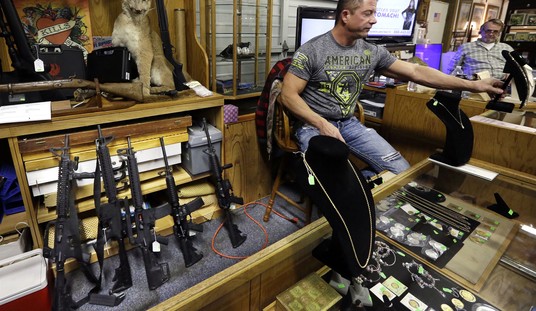When I saw that the Dallas Morning News had a multi-part series on gun tracing focused largely on guns recovered in Mexico, I couldn't help myself from cringing. The DMN editorial board has been a vocal supporter of gun control in the past, and I assumed that this series would slant heavily in favor of the claims of anti-gun activists that Mexico's violence can only be curbed by restricting our own right to keep and bear arms.
While the paper's reporting does feature anti-gun advocates like Global Action Against Violence's Jonathan Lowy, who's helping the Mexican government sue U.S. gunmakers over cartel violence, I was surprised to see the reporters actually took a fairly nuanced look at what gun traces can and can't tell us about crime.
Guns purchased from a single ZIP code in Grand Prairie, Texas, have been popping up in Mexico in significant numbers over the past several years.
From 2015-2022, the 75051 ZIP code was the source of more confiscated guns – roughly three dozen per year – in Mexico than from any other Texas ZIP code not located on the border.
Furthermore, a recent federal firearms report shows Texas is the nation’s leading supplier of illicit guns to Mexico’s drug cartels and other criminal organizations, representing 43% of the total.
Those are among the revelatory findings culled from a federal gun tracing database obtained by a nonprofit organization and analyzed recently by The Dallas Morning News.
At first glance, the data might suggest Grand Prairie is a hub for international arms trafficking. Dig a little deeper, however, and a more nuanced story emerges – one that not only reveals the challenges of firearms tracing as a tool against gun traffickers, but also illuminates the ongoing national debate between gun rights groups and gun safety advocates over whether such data should be made public.
Tracing can be helpful to agents, revealing patterns used by criminals and identifying possible suspects. And it can be used to alert gun sellers. But the data also can be of limited value when a gun’s serial number is filed off, when the sales paperwork is missing or when the firearms are old.
Those guns from Grand Prairie are a prime example.
The 275 Grand Prairie confiscated guns, it turns out, are very old. Some were bought so long ago that the North Texas gun store owners who sold them are long dead.
Pointing out the lengthy time-to-trace for those firearms is something that most media outlets fail to do when reporting on trace data. And the DMN went on to point out some of the flaws in the theory that U.S. gun stores are intentionally arming cartel members.
A 2009 Government Accountability Office report estimated that fewer than a quarter of guns recovered there were provided to ATF for tracing. And ATF reported last year that 73% of guns found in Mexico and other foreign countries cannot be traced to an initial buyer for various reasons. They include incomplete or invalid firearm information submitted by police; removed serial numbers and other markings; and missing or incomplete gun store sales records.
Another problem hindering gun tracing is the accuracy of the information submitted. ATF says Mexican authorities don’t always timely or accurately enter firearm makes, models and serial numbers into the tracing system.
To be sure, the Dallas Morning News provides plenty of space for gun control advocates who want the ATF to release more trace data that can be spun and manipulated to suit their purposes, as well as bans on so-called assault weapons. But they also spoke to folks like Larry Keane from the NSSF and retired ATF deputy assistant director Pete Forcelli, who argued that naming and shaming gun stores that have had a significant number of traces ignores the fact that high-volume dealers are likely to have more guns traced, and that these traces are not an indication of wrongdoing on the part of FFLs.
In fact, Forcelli pointed out that gun shops are typically the best allies for the ATF when it comes to combatting gun trafficking.
Forcelli said one of ATF’s best weapons against domestic and international arms trafficking is licensed firearms dealers and informants who tip them off to suspicious gun-buying activity. Red flags typically include making repeated cash purchases of guns known to be popular with the cartels.
Forcelli said 95% of his trafficking cases in Phoenix came from gun store tips.
Dallas ATF was tipped off, for example, about a suspected straw purchaser. An ATF agent said he received a call from a licensed dealer about Daniel Barbosa Chaparro’s “suspicious activity” at a gun store. Chaparro was taking photos of guns inside the unidentified store and buying them with cash, court records show. He drove a vehicle with Mexico license plates, records show, and used a paper license obtained just the day before.
Authorities arrested Chaparro in 2022 as he tried to cross the border with two assault rifles in his vehicle that he bought earlier that day, records said. Agents said his cell phone contained evidence that others were telling him what to do. He pleaded guilty and was sentenced in January to probation. His attorney declined to comment.
Why did federal authorities agree to such a sweet deal for Chaparro? Frustratingly, it doesn't appear that the DMN got a comment from the local U.S. Attorney about allowing a straw buyer to walk away on probation when he would have been eligible for a ten-year prison sentence if convicted.
Forcelli also reminded the Dallas Morning News readers that, in some cases, weapons traced in Mexico were allowed to cross the border thanks to the DOJ's disastrous Operation Fast & Furious.
Forcelli said guns from an ATF scandal known as Fast and Furious are still turning up in Mexico. From 2009 to 2010, Arizona agents allowed suspects to buy and smuggle about 2,000 guns into Mexico in the hopes of tracking them to high-ranking bosses. That didn’t happen and the guns continue to be used in crimes on both sides of the border.
One of the guns was found at the site of where U.S. Border Patrol agent Brian Terry was killed in 2010 in Arizona.
“Long after I’m dead,” Forcelli lamented, “Fast and Furious guns are still going to be turning up in parts of Mexico.”
ATF trace data is supposed to be a law enforcement tool, not a tool for gun control advocates. As we've seen with the release of the FFLs on the ATF's Demand 2 list, anti-gunners are willfully mispresenting their presence on the list as proof that they're doing something nefarious, when even the ATF itself says that selling guns that are later the subject of a trace is not evidence of wrongdoing on the part of the FFL. In fact, my biggest complaint about the DMN series is that it fails to put that disclaimer front and center in its reporting. Even with that issue, however, the reporters did a fairly decent job of covering both sides of the trace data debate; a welcome reprieve from the downright awful reporting we all too often see from the media when it comes to gun control and our right to keep and bear arms.









Join the conversation as a VIP Member